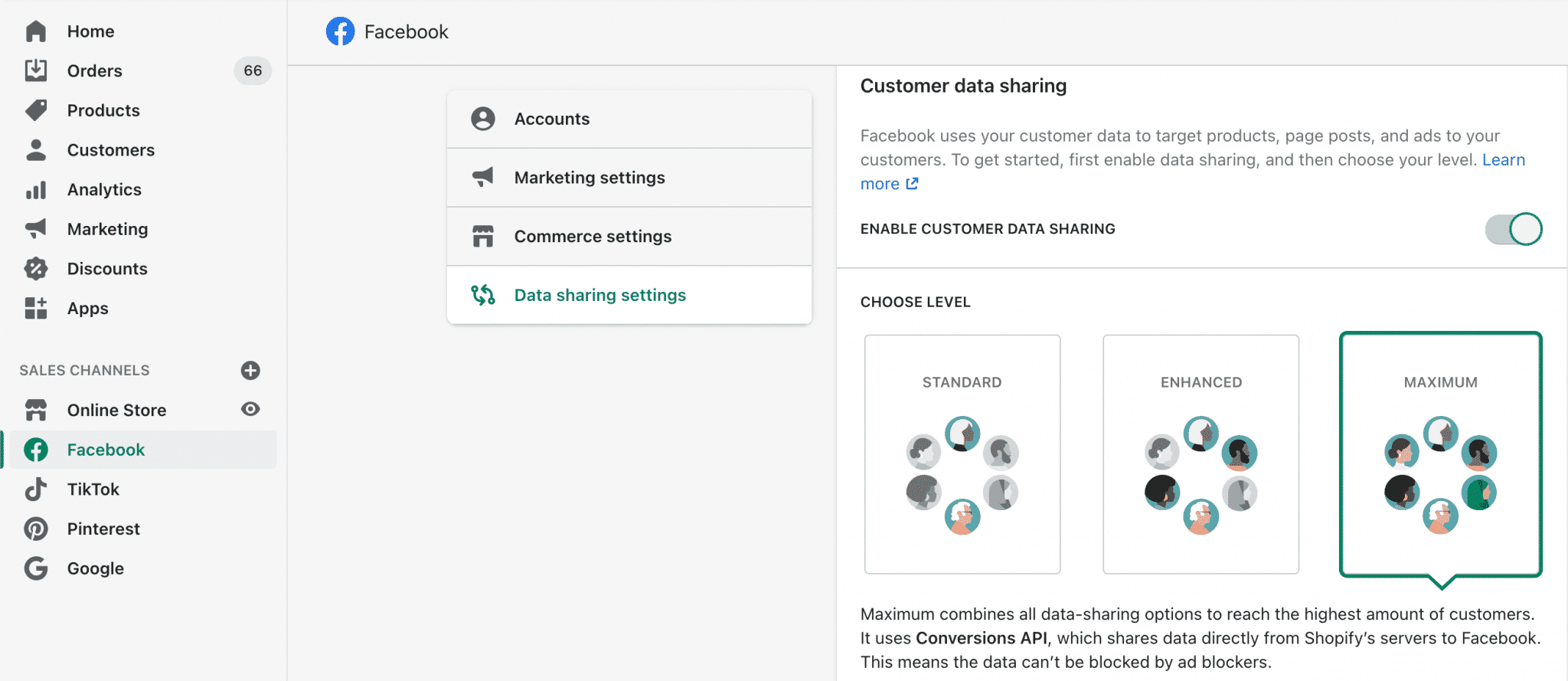Adapting to iOS 14.5: What Every Marketer Needs to Know
by Brittani Hunsaker • March 29, 2021
If you spend much time in online advertising (or if you’ve logged into Facebook Ads Manager this year), you’ve probably heard about iOS 14 and the IDFA armageddon.
And, if you’re like many businesses and advertisers, you probably did a bit of digging, figured it mostly boiled down to a shouting match between Apple and Facebook, and move on.
After all, there’s always some new update that promises to ruin online marketing forever. Capitalizing on our fear of the unknown, advertising gurus prophesy that “the end is near!” and then…not much happens.
The update rolls out, we all adjust and it’s back to business as normal. Sure, a few businesses (that are usually milking a loophole the update is designed to eliminate) get the short end of the stick, but most of us are just fine.
Over the years, I’ve seen several of these game-changing updates roll out and the game has always stayed about the same. It seems scary at first, but things turn out okay.
If this story rings true to you, you probably haven’t been too worried about the hype surrounding the IDFA apocalypse. However, regardless of whether or not iOS 14 spells the end of advertising as we know it, it’s still a big change. As advertisers, we’re going to have to adapt to a post-IDFA world.
So, in this article, we’re going to take a hard look at what’s changing, why it matters, how it might affect your business and what you can do to adapt. We won’t bother with the doom and gloom, we’ll just focus on the realities of the situation and what they mean to you.
Let’s dive in.
What’s Different About the IDFA Update
While it’s unlikely that iOS 14 will kill your ad campaigns, there is an important difference between this update and other “apocalyptic” advertising changes we’ve seen in the past: this change comes from Apple, not an advertising platform.
In the past, most of the doomsday advertising changes we’ve dealt with have been driven by the advertising platforms themselves. Algorithm changes. New ad types. Old ad types discontinued. Bigger ads (or smaller ads). Forced reliance on automation over manual optimization.
With each of these changes, advertisers have freaked out and worried that their ads would take a hit.

But here’s the thing: the ad platforms have a vested interested in making their advertisers successful. If they ruin things for their advertisers, their advertisers will leave…and the platform won’t make money any more.
So, when advertising platforms like Google or Facebook make an “apocalyptic” change, they do so very thoughtfully and carefully. These aren’t spur of the moment changes. A lot of data and testing goes into these decisions—no matter what it looks like from the outside.
The iOS 14 update, however, is different.
Apple doesn’t care about whether or not your business can advertise effectively on Facebook. Your ad spend isn’t a source of revenue for them (relatively speaking). Apple cares about making it’s customers happy.
And, in light of all the data and privacy breaches apps like Facebook have experienced in recent years, prioritizing privacy is a good way for Apple to make its customers happy. Even without the data breaches, most people don’t like ads—especially ads that are almost intrusively personalized.
So, unlike the “game-changing” updates we’ve seen in the past, the iOS 14 update doesn’t have our advertising best interests at heart. In fact, it’s quite the opposite.
What’s Changing with iOS 14
iOS 14 forces advertising platforms to do things differently in several ways. As you can probably imagine, those changes have downstream consequences for advertisers, so let’s take a look at what’s changing.
PCM Protocol
Perhaps the most significant effect of the iOS 14 update is the implementation of the Private Click Measurement (PCM) protocol. First introduced in May 2019 as a way for browsers to eliminate cross-site, cookie-based tracking of customer behavior, PCM basically hijacks tracking pixels and limits how much information an advertising platform can learn about a user.
Normally, here’s how cookie-based tracking works:
- Your ad (X) shows on an Apple app like Facebook.
- Joe sees your ad (X) and clicks on it.
- Facebook places a cookie in Joe’s browser as Joe arrives on your website.
- The Facebook cookie tracks Joe’s behavior on and off of your website, telling Facebook all kinds of useful things about Joe—whether he converts or not.
- If Joe converts, the cookie reports that Joe converted after clicking on ad (X) to Facebook. If he does not convert, you can use the cookie in Joe’s browser to continue remarketing to him.
As you can probably imagine, this sort of behavioral information is incredibly valuable to advertising platforms like Facebook and Google. It allows them to predict which users will respond best to certain types of ads, build detailed audiences and make constant micro-adjustments to your advertising.
But, in Apple’s opinion, advertising platforms shouldn’t be able to track someone who clicks on an ad anywhere and everywhere they go. It might make advertising algorithms more effective, but at the cost of users’ privacy.
With the PCM protocol, here’s how things go:
- Your ad (X) shows on an Apple app like Facebook.
- Joe sees your ad (X) and clicks on it.
- That click data is stored by Apple in his browser or the app.
- If Joe converts on the same browser or app within 7 days of clicking on ad (X), the browser sends a message to your pixel 24-48 hours later saying “someone clicked on ad (X) and converted”. Who clicked on the ad and what they did after is not reported. If Joe converts on a different browser or app (or on a different device), the conversion is not reported.
For businesses with impulse-buy products, apps or services, this change may not have a huge impact. For everyone else, though, the PCM protocol has the potential to wreak havoc on their audiences, conversion tracking and funnels.
At a minimum, though, this will affect all advertisers in a few key ways.
Conversion Tracking
Since Apple is effectively holding all of the data associated with your ads captive, their setup only allows them to store and send back a limited amount of data to advertising platforms like Facebook.
As a result, there is an 8-pixel event cap per domain for optimization. So, you’ll only be able to optimize for up to eight events in your Facebook campaigns. You can still track more events than that for reporting purposes, but Apple will only prioritize up to eight events.
Again, this will most heavily impact businesses with complicated funnels. If your funnel relies on numerous forms or conversion objectives, iOS 14 could really handicap your strategy—especially if your business (and advertising budget) is on the smaller side.
Measurement
Currently, the cookies placed in a browser by an advertising platform like Facebook can stay there pseudo-indefinitely. This allows advertisers to track the results of their advertising across whatever time period fits their buyer journey.
The PCM protocol, however, only retains click data for seven days, which means any conversions outside of that window won’t be reported back to the advertising platform. That can be a real problem for advertisers with long sales cycles.
Apple’s argument is that a user won’t remember seeing an ad for more than seven days, so why should that ad get credit for a sale that took longer than a week? I think most advertisers would argue with that mindset, but since Apple has made up its mind, we’re stuck with a 7-day attribution window.
Regardless of the length of your sales cycle, you can expect this one-size-fits-all attribution window to result in conversion under-reporting. In addition, it’s likely that we’ll see increases in “dark social” traffic, or traffic that comes from privately shared social media content.
In addition, since the PCM protocol randomly sends conversion data back to the platform sometime between 24 and 48 hours after a conversion takes place (to ensure that the advertising platform has no way to connect the conversion directly back to the click), there will be a three-day delay on data display for the data that comes from iOS 14 users.
This time-delay may not have a huge impact on large businesses that evaluate campaigns over weeks or months, but it may place a stranglehold on small businesses who have little extra cash to waste on non-productive campaigns.
After all, many small businesses make decisions on which ads to kill or keep based on just a few days (or even hours) of data. They don’t have time or money to wait for days to see if an ad is promising.
Since Facebook won’t be able to evaluate the actual performance of campaigns, ad sets and ads in real-time anymore, Facebook’s algorithms will be forced to play catchup. As a result, it’s likely that campaigns will take a lot longer to become truly effective, which means even more potential wasted money for smaller businesses.
Targeting
Whether they realize it or not, marketers have been heavily reliant on the wealth of data provided by cookies to date. Facebook tracks all kinds of information about its users—on and off of Facebook or Instagram—and uses that information to determine which users to show which ads.
Obviously, losing access to a lot of that data will have an impact on audience targeting. In addition, however, losing the ability to track which specific users click on your ads will also affect your ability to create retargeting and lookalike audiences.
This is where things get scary for many advertisers.
The more complex your sell is, the harder it is to convince someone to convert right away. Many advertisers deal with this by creating layered customer journeys where potential buyers are shown different ads as they progress towards conversion.
With iOS 14, however, that sort of progressive buyer journey becomes a lot more difficult. Retargeting audiences will become smaller as people opt out of tracking on iOS 14, making it harder and harder for advertisers to nudge prospects ever closer towards converting.
Again, this change will most likely affect small businesses the most. The obvious solution for large businesses is to use their email lists to build retargeting and lookalike audiences. It’s a step backwards, but not a crippling one.
Smaller businesses, however, often don’t have large email lists. Their customer base is fairly small, so they simply don’t have enough emails to run an effective remarketing campaign. Instead, they’ll be forced to rely on upper-funnel marketing efforts…even if their products or services take time to warm up to.
SKAdNetwork
Almost three years ago, Apple introduced what would eventually become a new API for developers interested in monetization. The API is called “SKAdNetwork”—a shorthand for “StoreKit Ad Network” in reference to “StoreKit”, which is how developers interact with the app store and facilitate in-app purchases.
While SKAdNetwork might be described as way for advertisers to “measure the success of ad campaigns”, Apple makes no secret out of the fact that SKAdNetwork’s primary objective is to protect the privacy of users who install mobile apps.
The SKAdNetwork offers far less data on app installs than was previously available. Now that Apple is transitioning to iOS 14, Facebook will be required to sue the SKAdNetwork API for app advertising on all iOS 14 devices.
What does that mean for app advertisers?
Well, at a minimum, it will delay event reporting for up to three days after an app is installed. In addition, lift measurement will be unavailable for iOS 14 App Install and App Events campaigns and event data will be restricted to a maximum of nine campaigns and five ad sets per campaign for every Facebook Ads account.
Most problematic of all, the SKAdNetwork only seems to properly attribute about 68% of conversions. That 32% inaccuracy can have a big impact on Facebook’s algorithms, potentially causing your ads showing up in front of the wrong people at the wrong time. In addition, it could lead you to make adjustments to campaigns based on bad data, further compromising your results.
Depending on your current app advertising strategy, these changes could require a complete overhaul of your Facebook campaigns. Or, it might not make that much of a difference. It all depends on how complex your advertising model is.
How Will iOS 14 Affect Your Business?
As you can probably tell, there are a lot of variables at play in this situation. Anything from your business size to what you’re advertising to your buyer journey can influence how iOS 14 will affect your business.
However, there are a few things to consider as try to assess iOS 14’s potential impact on your advertising:
Where Do Facebook Ads Fit Into Your Buyer Journey?
Different businesses use Facebook Ads in different ways. Facebook and Instagram Ads are generally low-purchasing intent ad platforms. As such, many businesses use Facebook Ads the same way they use display ads: to generate awareness.
If that’s true of your business, iOS 14 may not affect your advertising very much. If all you use Facebook Ads for is to get people into your funnel, it should still be an effective top-of-funnel channel.
However, if you rely on Facebook Ads for middle- or bottom-funnel advertising, the iOS 14 update could hurt. A lot.
This is especially true if you’re selling a product or service that requires a lot of explanation. Odds are that people won’t “get it” the first time they see your ad—or even if they do, they often need time to think about it—and your buyer journey is dependent on staying in front of those people until things finally click for them.
If this sounds like your business model, you will probably need to find alternative ways to stay in front of prospective customers. Create lead magnets. Build out your email lists. Invest into more email marketing. And, use those email lists to build out remarketing audiences so that you can still stay in front of potential customers on Facebook.
How Do Your Customers Find Your Business?
Depending on what you’re selling, your customers will find your business in different ways. If your products or services are something that people search for online, iOS 14 may not affect you very much. You might lose some remarketing sales, but Facebook Ads probably isn’t a central part of your advertising strategy.
If you’re selling something people wouldn’t think to buy otherwise, however, you may be reliant on Facebook Ads to build awareness for your business. In this situation, there are a few things that can influence whether or not iOS 14 has a significant effect on your business.
First off, are your customers using the Facebook mobile app on an iPhone? 80% of Facebook users only use Facebook on the mobile app. By comparison, just 1.7% use Facebook only on desktop.
However, if you know your audience and most of them fall into the 20% of users who use the desktop version of Facebook, you won’t be stuck dealing with the PCM protocol. So far, only the Safari browser uses the PCM protocol, so your customers will be cookied normally.
Similarly, even if most of your audience uses the Facebook mobile app, if the majority of them have Android devices, iOS 14 won’t have a huge impact on your advertising. While the iPhone is still the dominant smartphone in the US, Android devices are rising in popularity. If your target audience prefers Android, you may not have much to worry about.
Where Do You Do Most of Your Advertising?
Similarly, while the iPhone dominates the US smartphone market, only 8.9% of Facebook’s users are in the US. Outside of the US, Android devices are far more popular than the iPhone, so only 14.9% of the social media giant’s 1.8 billion users access Facebook on an iPhone.
Globally, 80.5% of Facebook users access the mobile app on Android.
So, if you do most of your sales outside of the US (and especially outside of the US, Europe and Australia), iOS 14 may be just a blip on your radar. But, if you do most of your sales in the US, you’ve got a lot more to worry about.
Adapting to iOS 14
At this point, you should have a pretty good feel for what the iOS 14 update entails and what sorts of problems it can cause for businesses. And, to put things simply, the more of these potential problems that your business has, the more likely your company is to take a hit from iOS 14.
If your business is selling impulse-buy T-shirts with funny sayings to people in South America, the update may not affect you much. But if you’re a US-based business trying to sell a new type of mattress with a complex value proposition, you may need to seriously rethink your marketing strategy.
Regardless of where you fall on this spectrum, though, there are a few changes to your Facebook/Instagram advertising strategy that you should definitely consider.
Verify Your Domain(s) with Facebook
Hopefully you’ve already done this, but if you haven’t verifying your domain gives you the ability to choose which eight conversion events you want Facebook to track.
Even if you don’t expect iOS 14 to have much effect on your ad performance, you’ll still want to do this because Facebook is implementing the eight conversion restriction across the board.
There are a variety of ways to verify your domain on Facebook. If you’re not particularly tech-savvy, you may need a developer’s help, but with the right skill set, you can verify your domain in just a few minutes.
To verify your domain, you basically just have to prove that you have access to the backend of your site. For example, you can add a DNS TXT entry from Facebook to your DNS record, upload a Facebook-provided HTML file to your web directory, or add a meta tag to the <head> section of your domain home page.
Again, hopefully you’ve already done this—since it’s required to grant certain permissions for your ad account—but if you haven’t, now’s a great time to make it happen!
Pick 8 Conversion Events to Track
As you can probably imagine, it’s a good idea to make sure Facebook is tracking the right conversion events in advance. You can only optimize for eight events, so you’ll want to take a look at your options and ensure that everything is selected and ranked properly in the Events Manager.
Both domain verification and conversion event selection have to be done by the pixel owner, so if you’re working with a partner agency, you may need to get on the phone and have them talk you through things.
If you have questions about what different conversion events mean or represent, you can check out Facebook’s official overview of “events” and this guide.
Review Your Attribution Window
Since you’ll soon be forced to adopt a 7-day post-click and 1-day post-view attribution window, you’ll want to take a look at your current attribution settings and review the available data to see how this change will affect your reporting.
If you’re already using 7/1 attribution, that’s great. If not, you may want to see what information you’ll be losing and see if there are any patterns you can find to account for the upcoming data losses. In addition, it’s probably a good idea to implement a system for tracking sales that occur from days 8-28 somewhere outside of Facebook.
Find Alternative Ways to Expand Your Funnel
One of the biggest challenges of iOS 14 is its effects on remarketing and lookalike audiences. These audiences are central to many businesses’ buyer journeys and prospecting campaigns. Without the ability to accurately identify and market to interested, specific users on Facebook, your funnel may begin to fall apart.
To solve this problem, you’ll want to find alternative ways to identify mid- and bottom-funnel prospects on Facebook. Incentivizing people to give you their email addresses, phone numbers or log into your site is a great place to start.
You may not be able to access as large of an audience as you’re used to with this approach, but with the right incentive and follow-up strategy, you may end up with a much higher-quality set of people to market to (and a wider set of channels to market with).
Email marketing is still one of the most profitable (and affordable) ways to market your business, so if you can’t get them to buy, at least try to get their email address!
Use the Facebook Conversion API
This final suggestion is on the more technical side, but it allows you to circumvent some of the fallout from iOS 14 by feeding visitor data from your website directly to Facebook. It’s not a perfect solution, but it does give you a way to get more of that oh-so-important data to Facebook faster and without having to go through the PCM filter.
As I just mentioned, this is a more complicated move, so you may need to hire an analytics expert to get you set up (we can help!). Or, if you’re using Shopify and have the Facebook Sales Channel set up, go to Facebook > Settings > Data sharing settings, switch on “Enable Customer Data Sharing” and then select “Maximum”.

If you aren’t using Shopify, we really recommend hiring someone to help, but if you want to get this set up on your own, here’s an overview of the Facebook Conversion API that should help you get started.
Rethink Your Strategy
Finally, if you’ve read through this article and you feel like your business is about to get creamed, now is a great time to sit down and rethink your online marketing strategy. There’s no guarantee that things will go south, but I’ve tried to present a very fair and unbiased assessment of the potential risks of this situation.
So, if you’re feeling worried, pay attention to your gut and take action now. Even if you’re wrong, coming up with new ways to expand your marketing outside of Facebook isn’t going to hurt you.
If you approach things the right way, an update like this doesn’t have to be scary. If anything, it’s an opportunity to get scrappy and explore new options for growing your business. You just have to be willing push forward instead of hedging your bets and hoping for the best.
Conclusion
The iOS 14 update promises to be…interesting. Like many of the “apocalyptic” changes we’ve seen in online advertising over the years, it probably won’t be as bad as some people make it out to be.
But, for many businesses, it will be a hurdle they have to work through.
As with every marketing challenge, the real question isn’t “Will this affect my business?” but “How will my business adapt to this change?” At this point, you should be aware of what to watch for and have some ideas for how to respond. The rest is up to you.
By the way, if you need help adapting to the challenges of iOS 14, let us know here or in the comments. We’d be happy to help!
What do you think about iOS 14? Do you agree with my assessment? How are you adapting your strategy to deal with these changes? Leave your thoughts in the comments below.





